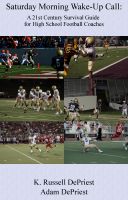A cover 2 scheme can be very effective for a defense because it allows more defenders to stay in the shorter passing lanes or pressure the passer. However, most high school defensive coordinators get into that cover 2 the same way every time: Simply dropping the free and strong safeties into a coverage that divides the deep "halves." This scheme is a textbook rotation into a cover 2 and is one of the more simple reads for a spread passing QB. Most offensive coaches will tell you that you will have a very long night on defense if you continue to show the same look and rotate into a coverage the same way. This is especially true for the pass only offenses that you see during a 7-on-7 tournament or camp.
So, as a defensive coach, how can you vary the coverage rotation so that you keep as many defenders as possible in the short zones while still playing a fundamentally sound cover 2 scheme? This article is intended to give a defensive coordinator some different ideas to confuse and frustrate a passing attack that usually feasts on cover 2.
In the video below, we first show a cover 2 base defense versus a "Doubles" formation. We then show different ways to rotate into that coverage beginning with a cover 3 base. Here is the order of the slides in the video.
1. Base Cover 2
2. Dropping the SS back to halves and rotating FS and LB's accordingly. As stated above, this is the most popular method to roll into cover 2.
3 & 4. Shift the LB's out to cover for a CB that will drop into deep halves. #3 is the same as #2, just going the opposite way.
5. Pull the FS down and drop the SS and OLB into deep halves.
6. This is not roll as much as a variation of cover 2. Cover 2 Buc (or Tampa 2) which is actually a hybrid cover 3 of sorts as the MLB drops into the deep middle while the two safeties can cover further outside the hash. This keeps teams from exploiting the deep middle -- the weakness of the cover 2 defense.
By no means is this an exhaustive list, but hopefully this will give you some ideas to work from. The reason this can be effective is that, when you are facing good teams where the quarterback is making pre-snap reads and the receivers are adjusting routes based on coverage, it can confuse either or both. This confusion will lead to positive plays for your 7-on-7 defense.
--
*Since older posts are sometimes hard to find, we are re-posting this. We hope this helps in developing a successful scheme for your 7-on-7 football defense.
skip to main |
skip to sidebar
Sponsored Links
Blog Archive
-
►
2015
(33)
- ► December 2015 (5)
- ► November 2015 (9)
- ► October 2015 (8)
- ► September 2015 (8)
- ► August 2015 (2)
- ► April 2015 (1)
-
►
2014
(41)
- ► December 2014 (6)
- ► November 2014 (8)
- ► October 2014 (9)
- ► September 2014 (7)
- ► August 2014 (3)
- ► March 2014 (1)
- ► January 2014 (3)
-
►
2013
(53)
- ► December 2013 (6)
- ► November 2013 (8)
- ► October 2013 (9)
- ► September 2013 (8)
- ► August 2013 (1)
- ► March 2013 (1)
-
►
2012
(59)
- ► December 2012 (5)
- ► November 2012 (8)
- ► October 2012 (11)
- ► September 2012 (10)
- ► August 2012 (3)
- ► March 2012 (5)
-
▼
2011
(96)
- ► December 2011 (5)
- ► November 2011 (8)
- ► October 2011 (10)
- ► September 2011 (8)
- ► August 2011 (1)
-
▼
April 2011
(11)
- Update #1 - 2011 Arkansas Football Camp and 7-on-7...
- 2011 Ouachita Baptist University Football Camps
- *Cover 2 Pass Defense in 7-on-7 Football
- 2011 Southern Arkansas University Football Camps
- "Head Games: Football's Concussion Crisis" Book R...
- 2011 SEArk Shootout Date
- ArkansasVarsity.com All-State Football Combine
- Battle of the Trenches Lineman Camp
- Initial 2011 Arkansas Football Camp and 7-on-7 Tou...
- 4th Annual East Texas Baptist University Tournamen...
- 2011 Henderson State University Senior/Junior Camps
- ► March 2011 (2)
-
►
2010
(28)
- ► December 2010 (4)
- ► November 2010 (6)
- ► October 2010 (1)
- ► April 2010 (1)
- ► March 2010 (2)
- ► January 2010 (1)
-
►
2009
(34)
- ► December 2009 (3)
- ► November 2009 (6)
- ► October 2009 (4)
- ► September 2009 (2)
- ► April 2009 (1)
- ► March 2009 (2)
- ► February 2009 (2)
-
►
2008
(61)
- ► December 2008 (2)
- ► November 2008 (6)
- ► October 2008 (6)
- ► September 2008 (8)
- ► August 2008 (2)
Other Great Sites
Summer Camps
Sponsored Links
Topics
- 2008 (42)
- 2009 (28)
- 2010 (27)
- 2011 (87)
- 2012 (55)
- 2013 (50)
- 2014 (38)
- 2015 (33)
- 7-on-7 Defense (2)
- 7-on-7 Offense (2)
- Camps (10)
- Free For All (26)
- General (32)
- Lineman (8)
- Rankings (2)
- Saturday Morning Wake-Up Call (14)
- Scoring 70 (11)
- Scoring 80 (1)
- Tournaments (32)
- Why 7-on-7 (3)







No comments:
Post a Comment